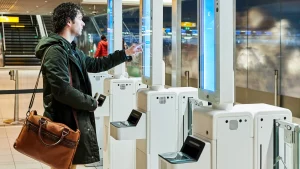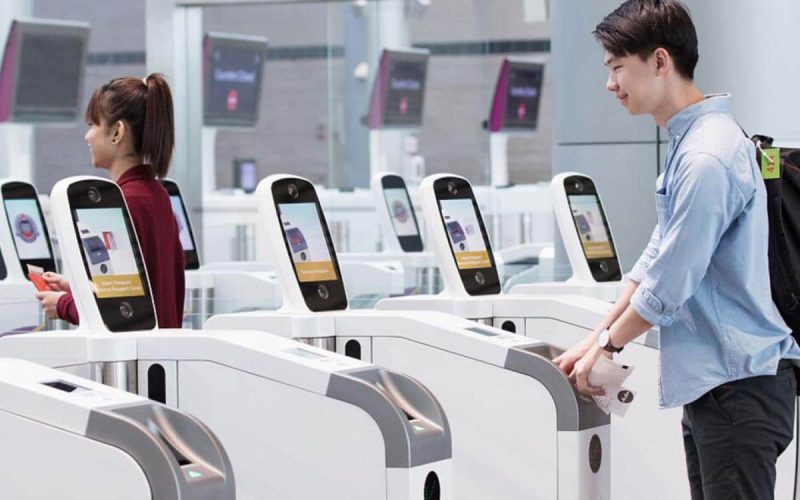In the rapidly evolving landscape of air travel, the integration of biometric technology in airports has emerged as a transformative force. This paradigm shift, driven by the need for enhanced security, streamlined operations, and improved passenger experiences, is reshaping the way we navigate through airports.
Understanding Biometric Technology
Biometric technology refers to the use of unique biological traits—such as fingerprints, facial recognition, iris scans, and voice recognition—to identify and authenticate individuals. Unlike traditional identification methods that rely on physical documents, biometric systems offer a higher level of accuracy and security by leveraging the distinct characteristics inherent to each person.

Drivers Behind the Adoption
Security Enhancement: In an era where security threats are ever-evolving, airports are under constant pressure to adopt measures that ensure passenger safety. Biometric technology provides a robust solution by minimizing the risk of identity fraud and unauthorized access.
Operational Efficiency: Airports are bustling hubs where time is of the essence. Biometric systems expedite the check-in, boarding, and security screening processes, reducing wait times and congestion. This efficiency not only benefits passengers but also optimizes airport operations.
Passenger Experience: Modern travelers demand seamless and hassle-free journeys. Biometric technology enables a frictionless experience by eliminating the need for multiple identity verifications. Passengers can move through various checkpoints with ease, enhancing their overall satisfaction.
Airports
The implementation of biometric technology spans various touchpoints within the airport ecosystem:
Check-in and Bag Drop: Biometric kiosks and bag drop stations equipped with facial recognition or fingerprint scanners allow passengers to check in and drop off their luggage swiftly. This self-service approach reduces queues and enhances convenience.
Security Screening: Biometric systems at security checkpoints streamline the screening process by verifying passenger identities with high precision. This reduces the need for manual document checks, expediting the flow of passengers.
Boarding Gates: Facial recognition technology at boarding gates ensures that only authorized passengers board the aircraft. This not only enhances security but also accelerates the boarding process, minimizing delays.
Immigration and Customs: Biometric e-gates at immigration and customs checkpoints enable swift and accurate identity verification. This facilitates smoother international travel and reduces bottlenecks at border control.
Global Implementation
The adoption of biometric technology in airports is a global phenomenon, with notable implementations across various regions:
United States: Major airports in the U.S. have embraced biometric technology to enhance security and passenger throughput. The Transportation Security Administration (TSA) has deployed facial recognition systems at several airports, streamlining the security screening process.
Europe: European airports are at the forefront of biometric innovation. For instance, London’s Heathrow Airport and Amsterdam’s Schiphol Airport have integrated biometric systems to expedite passenger processing and enhance security measures.
Asia-Pacific: Airports in Asia-Pacific countries, such as Singapore’s Changi Airport and Hong Kong International Airport, have implemented cutting-edge biometric solutions to provide a seamless travel experience for passengers.
Middle East: Dubai International Airport and Hamad International Airport in Doha have adopted biometric technology to enhance operational efficiency and security, positioning themselves as leading hubs in the region.
Challenges and Considerations
While the rise of biometric technology in airports offers numerous benefits, it also presents certain challenges and considerations:
Privacy Concerns: The collection and storage of biometric data raise privacy and data protection concerns. Airports must implement robust data security measures and adhere to regulatory requirements to safeguard passenger information.
Technical Reliability: The accuracy and reliability of biometric systems are critical. False positives or negatives can disrupt operations and erode passenger trust. Continuous testing and maintenance are essential to ensure optimal performance.
Cost and Infrastructure: The deployment of biometric technology requires significant investment in infrastructure and training. Airports must carefully evaluate the costs and benefits to justify the implementation of such systems.
User Acceptance: Passenger acceptance of biometric technology varies. Clear communication and education about the benefits and security of biometric systems are essential to gain user trust and acceptance.

Future Prospects
Integration with Mobile Devices: The convergence of biometric technology with mobile devices could enable passengers to use their smartphones for identity verification, further enhancing convenience and security.
AI and Machine Learning: The integration of artificial intelligence and machine learning algorithms can enhance the accuracy and efficiency of biometric systems, enabling real-time threat detection and response.
Global Standards and Collaboration: The establishment of global standards and collaboration among airports, airlines, and regulatory bodies can facilitate the seamless implementation and interoperability of biometric systems across different regions.
Conclusion
The rise of biometric technology in airports signifies a pivotal shift towards a more secure, efficient, and passenger-centric air travel experience. As airports continue to embrace and refine these technologies, the benefits will extend beyond security and operational efficiency, ultimately redefining the way we navigate the skies. The journey towards a biometric future is not without challenges, but with careful consideration and collaboration, the aviation industry is poised to soar to new heights.












